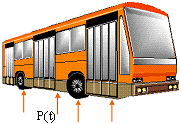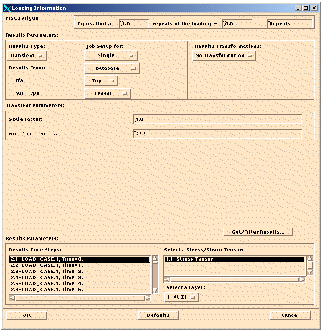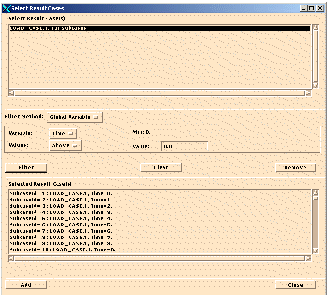XXXXXXXXXXXXXXXXXXXXXXXXXXXXXXXXXXXXXXXXXXXXXXXXXXXXXXXXXXXXXXXXXXXXXXXXXXXXXXXXXXXXXXXXXXXXXXXXXXXXXXXXXXXXXXXXXXXXXXXXXXXXXXXXXXXXXXXXXXXXXXXXXXXXXXXX''"> Analysis Using Transient Results
Up to this point we have strictly used linear elastic FE results from static load cases where we have associated the time variation of the loading to externally defined time histories. This is the most common usage of MSC Fatigue and perfectly valid for most components and structures which are fairly stiff in nature. Thus the name quasi-static. The assumption is made that dynamic effects are third or fourth order contributions to fatigue life and therefore ignored.
There are times, however, where the dynamics of the structure can significantly effect the fatigue life of the product, especially when the mass of the structure is large and the operating loads approach or even pass through the natural frequencies of the structure such as the dynamics of an entire vehicle body as shown by the bus to the right.
In these cases it is generally better to use a dynamic FE analysis to capture all the important dynamic effects. All time variations of the loading are defined directly in the FE model and a direct or modal dynamic transient analysis is performed. There is no need for any externally defined and associated time histories as with the pseudo-static method. The drawback however, is that you cannot separate the loads. They must all be defined in the same FE analysis. Investigation of the influence each load may have on fatigue life requires a new FE analysis to be run each time.
To illustrate the use of transient results in MSC Fatigue, follow this mini-exercise:
Transient Keyhole Job
The geometry is the same keyhole model. Open a new database called keyhole and import the MSC Nastran Output2 file call, key_tran.op2. In addition to this transient analysis, we are also going to compare the answers to an equivalent pseudo static analysis, so also read in the Output2 file, key_stat.op2. Remember to read the model and results for the first file and only the results for the second file in the order specified here.
In this version of the keyhole model, the static load case results were determined using a 30 Newton loading at the same point of application as the original keyhole problem, the results from which, when scaled by the load time history should give roughly equivalent stress time histories for all nodes as does the modal transient analysis. This of course does not take into account any dynamic effects that the mass distribution may have on the dynamic behavior and resulting stress results. However, with this simple model and a very evenly distributed mass, there should not be a large difference.
Open the main MSC Fatigue setup form and read in the saved job called transient using the file transient.fin. You will also need static.fin, so copy this file while you are at it. Systematically open the Solution Params..., the Material Info..., and the Loading Info... forms and follow the explanations of each to understand the setup. Note that we are running a Crack Initiation analysis.
Solution Parameters
Open the Solution Params... form. All the defaults have been selected for this analysis.
Material Information
Open the Material Info... form. The material chosen is the MANTEN steel alloy with a Polished finish and the treatment set to No Treatment. The material already resides in the materials database.
Loading Information
Open the Loading Info... form. This is where the analysis setup differs when using transient FE results. For the transient analysis the loading time history is defined by the FE analysis in the input deck and therefore it is not necessary to create externally. You will notice that the Loading Info... form appears quite a bit different than for a pseudo-static setup. The following observations are made:
1. The Results Type is set to Transient. This is the controlling setting for the appearance of this form.
2. Note that no access to the Time History Manager is available when set to Transient since this is unnecessary.
3. Results can be extracted from, this is the results from widget, three different sources: Database, MSC Patran FEA, or External, with the Database being the most common source.
Note: | External PATRAN Results files can be accessed in the same manner as for pseudo-static cases with multiple loading except the # symbol in the file name now refers to the time step number. They must start at 1 and exist up to the number of time steps indicated, e.g., filename1.node, filename2.nod, ... |
4. A scale factor is allowed to uniformly scale the FE results for all time steps selected.
5. For results extracted from the database, you must filter all the time steps you wish to include in the analysis using the Get/Filter Results... button. Only the time step you want must appear in the Result Time Steps listbox. The Number of Time Steps selected is indicated in the databox below the Scale Factor and is dimmed and unchangeable since the number of items in the listbox determines the number of time steps.
For example if you open the Get/Filter Results... form and select LOAD_CASE.1 in the top list box, and set the Filter Method to Global Variable with the Variable set to Time and press Filter, you will get all time steps associated with this Result Case. You can individually remove time steps you do not want by selecting them in the lower listbox and clicking the Remove button. Press the Add button to place all selected time steps into the Result Time Steps listbox on the Loading Info... form. Click the Close button to close down the Select Result Cases form.
6. Finally you must select the stress or strain tensor (and layer if applicable) to use in the analysis. This is simply done by selecting one of the time steps in the Results Time Steps listbox. Then you select the stress or strain tensor in the adjacent listbox. There is no need to fill in any spreadsheet as with the pseudo-static method.
To summarize the Loading Info... form for Database results:
• Supply a Scale Factor if desired
• Get/Filter Results... to include only the time steps of interest
• Select one of the time steps in the Results Time Steps listbox (all will be used in the analysis)
• Select a stress or strain tensor from the Select a Stress/Strain Tensor listbox
• Select a Layer if necessary
• Check that the No. of Time Steps agrees with your expectation
Job Control
Open the Job Control... form and submit the analysis. Monitor it if desired.
Static Keyhole Job
We also wish to run a fatigue analysis from pseudo-static results for comparison purposes. Now run the equivalent analysis using static FE analysis results.
First a time history must be created by reading in an ASCII version of this time history that is equivalent to the force time history used in the transient analysis. Copy over the file called key_tran.asc. The following PTIME keystrokes will accomplish this for you:
1. Invoke PTIME either from the system prompt or from the Loading Info... form by pressing the Time History Manager button (Results Type = Static).
2. Use Add an entry | ASCII convert + load
3. Select the ASCII file key_tran.asc.
4. Accept this form by clicking OK.
5. Enter at least one descriptive title on the next form. Accept the defaults for the rest of the fields and click the OK button.
6. Plot the time history if you wish and exit when finished.
Now read in the static fatigue setup from the static.fin file. View the setup if desired and then open the Job Control... form and submit the job.
Evaluate Results
Finally read or list the results from the two jobs to see that they are approximately the same (2100-2600 repeats). There is a difference between the two which is due to the fact that the modal transient takes into account the dynamic effects of the mass distribution whereas the pseudo-static does not, as mentioned earlier.
The differences would be even greater for models with more mass and for loading services that approached the natural frequencies of the structure.



